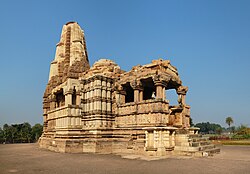Khajuraho
Khajuraho | |
|---|---|
City | |
 Dulhadeo Temple | |
| Coordinates:24°51′00″N79°55′30″E/ 24.85000°N 79.92500°E | |
| Country | |
| State | Madhya Pradesh |
| District | Chhatarpur |
| Elevation | 283 m (928 ft) |
| Population (2011) | |
| • Total | 24,481 |
| Time zone | UTC+5:30(IST) |
| Vehicle registration | MP-16 |
| Sex ratio | 1100♂/♀ |
Khajuraho() is a city, nearChhatarpurinChhatarpur districtof theIndian stateofMadhya Pradesh.One of the most populartourist destinations in India,Khajuraho has the country's largest group ofmedievalHinduandJaintemples,famous for theirerotic sculptures.TheKhajuraho Group of Monumentshas been listed as aUNESCOWorld Heritage Sitesince 1986 and is considered one of the "seven wonders" ofIndia.The town's name, anciently "Kharjuravahaka", is derived from theSanskritwordkharjurmeaning "date palm".
History
[edit]The region was historically part of many kingdoms and empires. The earliest known power to have had Khajuraho in its territory were theVatsa.Their successors in the region included theMauryans,Sungas,Kushans,Nagas of Padmavati,theVakataka dynasty,theGuptas,thePushyabhuti dynasty,and theGurjara-Praithara dynasty.It was specifically during the Gupta period that architecture and art began to flourish in this region, although their successors continued the artistic tradition.[1]
TheChandelasruled the area from the ninth century, who were subject to the Gurjara-Praitharas. During the reign of Dhanga (c. 950–1002) the Chandelas became independent and many important temples were built during this time. The Chandelas were dealt with fatal blows first from theChahamanas of Shakambhariin 1182 then fromQutb al-Din Aibakin 1202. Khajuraho declined to a small village as the Chandelas transferred their activities to the forts of Mahoba, Kalinjar, and Ajayagarh.[1]
Ibn Battutavisited Khajuraho and described the presence of temples and a few ascetics. Some temples were damaged bySikander Lodiin 1495. By the 16th century Khajuraho became an insignificant place and was only "rediscovered" by C. J. Franklin (a military surveyor) in 1819. However, the actual distinction of bringing Khajuraho back to the world's attention is given to T. S. Burt (a British army captain) who visited it in 1838. The next significant visitor wasAlexander Cunninghambetween 1852 and 1855.[1]
Climate
[edit]| Climate data for Khajuraho (1981–2010, extremes 1970–2010) | |||||||||||||
|---|---|---|---|---|---|---|---|---|---|---|---|---|---|
| Month | Jan | Feb | Mar | Apr | May | Jun | Jul | Aug | Sep | Oct | Nov | Dec | Year |
| Record high °C (°F) | 34.3 (93.7) |
38.6 (101.5) |
43.1 (109.6) |
46.9 (116.4) |
48.4 (119.1) |
48.0 (118.4) |
45.0 (113.0) |
41.0 (105.8) |
39.3 (102.7) |
42.8 (109.0) |
37.6 (99.7) |
32.8 (91.0) |
48.4 (119.1) |
| Mean daily maximum °C (°F) | 24.1 (75.4) |
28.0 (82.4) |
34.3 (93.7) |
40.1 (104.2) |
42.8 (109.0) |
40.4 (104.7) |
34.3 (93.7) |
32.5 (90.5) |
33.2 (91.8) |
33.8 (92.8) |
30.1 (86.2) |
26.1 (79.0) |
33.3 (91.9) |
| Mean daily minimum °C (°F) | 8.4 (47.1) |
10.8 (51.4) |
15.8 (60.4) |
21.9 (71.4) |
26.9 (80.4) |
28.4 (83.1) |
26.3 (79.3) |
25.3 (77.5) |
24.1 (75.4) |
19.0 (66.2) |
13.3 (55.9) |
9.2 (48.6) |
19.1 (66.4) |
| Record low °C (°F) | 1.0 (33.8) |
0.6 (33.1) |
6.3 (43.3) |
12.6 (54.7) |
18.6 (65.5) |
21.5 (70.7) |
22.4 (72.3) |
21.8 (71.2) |
17.3 (63.1) |
11.7 (53.1) |
4.8 (40.6) |
3.1 (37.6) |
0.6 (33.1) |
| Average rainfall mm (inches) | 17.8 (0.70) |
22.8 (0.90) |
10.6 (0.42) |
6.5 (0.26) |
15.7 (0.62) |
100.0 (3.94) |
293.7 (11.56) |
377.0 (14.84) |
211.6 (8.33) |
33.9 (1.33) |
6.7 (0.26) |
3.8 (0.15) |
1,100 (43.31) |
| Average rainy days | 1.3 | 1.6 | 0.9 | 0.8 | 1.5 | 5.5 | 13.0 | 13.6 | 8.7 | 1.7 | 0.5 | 0.6 | 49.9 |
| Averagerelative humidity(%)(at 17:30IST) | 47 | 37 | 24 | 17 | 20 | 40 | 69 | 76 | 68 | 48 | 44 | 48 | 45 |
| Source:India Meteorological Department[2][3] | |||||||||||||
Demographics
[edit]As of 2011[update],the Indiancensusstated that Khajuraho had a population of 24,481. Males constitute 52% of the population and females 48%. Khajuraho has an average literacy rate of 53%, lower than the national average of 74.04%: male literacy is 62%, and female literacy is 43%. In Khajuraho, 19% of the population is under six years of age.
Transport
[edit]Air
[edit]Khajuraho Airporthas flights toDelhiandVaranasi.The airport is 3 km south of Khajuraho Town, and was opened in 1978 to facilitate tourism to the nearbyUNESCOworld heritage sitetemple complex.[4]Concerns have been raised by experts regarding the feasibility of this airport and its impact on the world heritage site and the environment.
Rail
[edit]Khajuraho railway stationconnects the town by a daily train from New Delhi (18:20Hrs) viaChhatarpur,Tikamgarh,Jhansi, Gwalior, Agra, and Mathura; namely the Kurukshetra-Khajuraho Express (11842); journey takes about 13:30 hours. 11841 starts from Khajuraho (18:35Hrs) reaching New Delhi (08:45 next day). Vande Bharat (22470) Express runs daily from H.Nizamuddin (06:00Hrs) to Khajuraho (14:20Hrs) in 8:20 hours; return by 22469; 14:50-23:10; as on September 2024. PLEASE CHECK TIMING AND OTHERS FROM INDIAN RAILWAYS. It provides a daily train connecting to Agra, Jaipur, Bhopal and Udaipur. A local daily train also connects to Kanpur, whilst Varanasi is connected three times a week..[5]
References
[edit]- ^abcSchellinger, Paul; Salkin, Robert, eds. (1996).International Dictionary of Historic Places, Volume 5: Asia and Oceania.Chicago: Fitzroy Dearborn Publishers. pp. 468–469.ISBN1-884964-04-4.
- ^ "Station: Khajuraho Climatological Table 1981–2010"(PDF).Climatological Normals 1981–2010.India Meteorological Department. January 2015. pp. 409–410. Archived fromthe original(PDF)on 5 February 2020.Retrieved29 December2020.
- ^ "Extremes of Temperature & Rainfall for Indian Stations (Up to 2012)"(PDF).India Meteorological Department. December 2016. p. M121. Archived fromthe original(PDF)on 5 February 2020.Retrieved29 December2020.
- ^"Khajuraho airport equipped with infrastructure to boost tourism: Union minister Ganpathi Raju".Pradesh18.com.Press Trust of India.23 January 2016.Retrieved13 January2017.
- ^"Khajuraho Departures".


